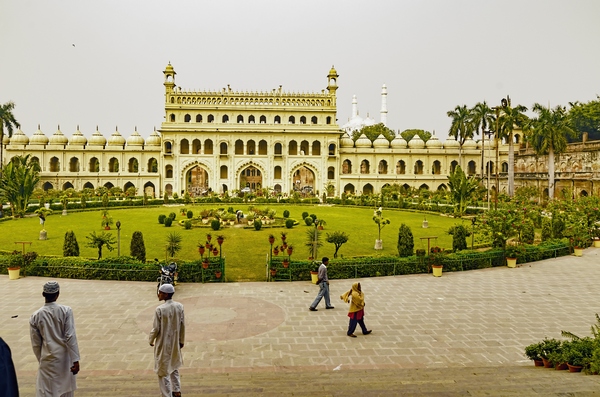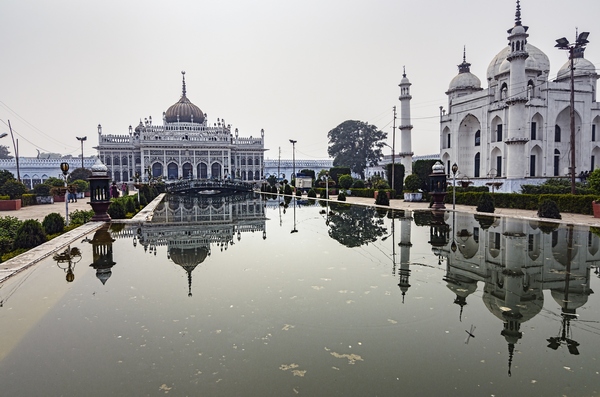Floods and famines bring untold misery. But sometimes they provide an opportunity to show compassion and to extend a helping hand. During the golden age of the Pharaohs, some 4500 years ago, the Great Pyramids were built in Giza in Egypt. Contrary to legend, they were not built by slaves driven by whiplashes, but by skilled artisans assisted by an entire country’s peasant population driven away from their fields by very heavy floods in the river Nile. The Pharaohs got their glory and their mausoleums while the displaced peasants got food and employment in time of dire need.
History repeated itself some 4000 years later and 3000 miles away when a terrible famine lay waste the kingdom of Avadh in Northern India. The Nawab, Asif-u-Daulla decided to build the Great Imambara or the “Patriarch’s Place” revered by the Shia Muslims in memory of the grandsons of the Prophet Muhammad. The construction provided work for his starving people. Eventually, the building finished in 1764 was to house his tomb and proclaim his piety to the world. It is known today as the Asifi Imambara. Barely 54 years later, history repeated itself and a second famine prompted the then Nawab Mohammad Ali Shah, to build a second smaller but more aesthetically pleasing Imambara known today as the Hussainabad Imambara, a striking example of Indo-Saracen architecture. This structure too was to house the builder-Nawab’s tomb much as the Pyramids served as the final resting place of the Pharaohs of ancient Egypt.
So while the Nile floods led to the ancient marvels of the Pyramids of Giza, Egypt, famines prompted the construction of the two prominent landmarks for Lucknow, the two Imambaras. While the Imambaras are not pyramidal, they are indeed a remarkable legacy of the Muslim rule of India.
THE BIG BROTHER
There are two Imambaras in Lucknow, close to one another. The larger Asifi Imambara is the grander one. Started in 1785, 20,000 workmen toiled and built what is still the largest building in the modern city of Lucknow. The central hall which houses the grave of its creator is said to be the largest vaulted hall in the world. It is 165 feet by 200 feet and 50 feet high. It was built with small bricks and lime mortar without steel reinforcements, uninfluenced by European style of architecture in vogue in those days. The hollow walls kept the structure cool during summer. A whispering gallery and a labyrinth add to the mystique of the Imambara. Built as a place of worship and also as a source of livelihood during hard times, the Imambara became the final resting place of its creator-Nawab Asif-ud-Daula.

SMALL IS BEAUTIFUL
Just about 54 years later, a smaller but handsomer Imambara called the Hussainabad Imambara, also called the Palace Of Light was built by Mohammad Ali Shah in 1839. Once again, the purpose was to feed starving subjects suffering from another great famine. Though smaller, this Imambara is an excellent example of Indo-Saracen art, which evolved out of the fusion of the Islamic Saracen Palladine style of architecture and Victorian Gothic used in the construction of many landmark buildings of British India such as the Victoria Terminus in Bombay and the Victoria Memorial in Calcutta.

Perhaps unintentionally inspired by the Pyramids, two Sphinxes guard the main gate. In the center of the quadrangle is a masonry tank with an iron bridge across it. On the west side stands a white pavilion that looks like a copy of the Taj Mahal. This is the tomb of the Nawab’s daughter Janabasya. On the east is another building of nearly similar proportions, built to balance the facade. On the right, there is a small mosque for an exclusive use of the surviving heirs and successors of Nawab’s family. The Imambara stands on the southern side of the quadrangle and contains the tombs of the Nawab and his mother.

LEGENDS OF THE IMAMBARAS
Tales of the Imambara
The Larger Asifi Imambara has its share of legends though not as hair-raising as the ones associated with the Pyramids. For instance, there is a blocked tunnel which, according to legends, leads through a mile-long underground passage to a location near the Gomti river which flows through Lucknow. Other passages are rumored to lead to Faizabad the former seat of power of the Nawabs, to Allahabad and even to Delhi. The tunnels still exist but are blocked after several intrepid explorers have gone missing after entering them. There is also a labyrinth on the first floor of the Imambara, where the unwary may easily get lost although there is no fearsome Bull-Man, like the Minotaur lurking in its darkness.
Penelope’s Tapestry
When Odysseus king of Ithaca was believed to have died in the Trojan wars, a host of suitors descended on his wife Penelope seeking her hand and thus the kingdom as well. To evade them Penelope promised to choose a mate as soon as her tapestry was finished. She would weave all day and by candlelight, undo the day’s weaving at night. Her deception lasted for over three years, giving time for her husband’s delayed return.
It is believed that to ensure continuing jobs for his subjects during the great drought, Nawab Asif-ud-Daula did much the same. The large Imambara was constructed all day and in the dead of night dismantled brick by brick so that the work would continue as long as the drought lasted!
Comparisons are Odious
Comparisons are odious and it is indeed a tall order to compete with one of the 7 wonders of the ancient world. But in their own way, the two Imambaras make a statement about the Nawabi past of the city of Lucknow bearing testimony to the compassionate aspects of the Muslim rulers of Oudh otherwise known for exquisite courtly manners, mouth water cuisine, the culture of the classical music, beautiful courtesans and of course, mind-blowing profligacy!
by Jayant Neogy, a student of photography who loves to travel
Well researched and beautifully researched article….wonderful photos!
The pictures are excellent, highlighting details. One often sees good photographs but it is not often that script and photographs are so well blended. There is so much depth and research in your photo stories. Congrats.
Usha
Many thanks, Manju and Usha!